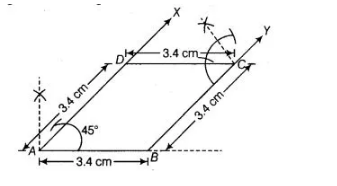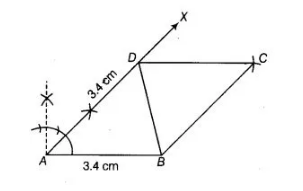Construct a rhombus whose side is of length 3.4 cm and one of its angles is 45°.
We know that, in rhombus all sides are equal. To construct a rhombus whose side is of length $3.4 \mathrm{~cm}$ and one of its angle is $45^{\circ}$, use the following steps
1. Draw a line segment AS of length $3.4 \mathrm{~cm}$.

2. Now, generate an angle $45^{\circ}$ at both ends $A$ and $B$ of line segment $A B$ and plot the parallel lines $A X$ and BY.
3. Cut $A D$ and $S C$ of length $3.4 \mathrm{~cm}$ from $A X$ and $B Y$, respectively.
4. Draw an angle of $45^{\circ}$ at one of the point $D$ or $C$ and join both points by a line segment $D C$ of length $3.4$ $\mathrm{cm}$ and parallel to $\mathrm{AB}$.
Thus, $A B C D$ is the required rhombus whose side is of length $3.4 \mathrm{~cm}$ and one of its angle is $45^{\circ}$.

Alternate Method
To construct a rhombus whose side is of length $3.4 \mathrm{~cm}$ and one of its angle is $45^{\circ}$, use the following steps.
1. Draw a line segment $A B$ of length $3.4 \mathrm{~cm}$.
2. Now, draw an angle $X A B=45^{\circ}$ at point $A$ of line segment $A B$.
3. Cut a line segment $A D=3.4 \mathrm{~cm}$ from the ray $A X$ and join $B D$.
4. Now, from $D$ point $C$ is at a distance of $3.4 \mathrm{~cm}$. So, having $D$ as centre draw an arc of radius $3.4 \mathrm{~cm}$.
5. From $B$, point $C$ is at distance of $3.4 \mathrm{~cm}$. So, having $B$ as centre draw an arc of radius $3.4 \mathrm{~cm}$ which intersect previous arc (obtained in step iv) at $C$.
6. Join $C D$ and $B C$.
Thus, $A B C D$ is required rhombus whose side is of length $3.4 \mathrm{~cm}$ and one of its angle is $45^{\circ}$.
